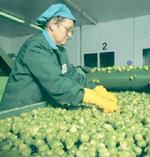| Fruits |
Vegetables
|
Brussels sprouts, Brassica oleracea var. gemmifera / Cruciferae (Brassicaceae)
Postharvest Atmosphere Management

Brussels sprouts must be precooled after their harvesting, since they are highly perishable products. They are preserved up to one month at 0ºC and 90-95% of humidity. In order to preserve them longer, the controlled atmosphere is needed, maintaining oxygen levels to 1-2% and carbon dioxide to 5-7%; nevertheless; this system is not used commercially.
Brussels sprouts must be precooled before they are put in cold storage rooms, specially when they are harvested under high temperatures. This is possible with ice or with a technique consisting of the dampening of the sprouts and vacuuming. Whichever the method used, the temperature must be between 0 and 4ºC.
Although Brussels sprouts are generally commercialised immediately after their harvesting, they are stored if the situation requires it. It is recommended a temperature of 0ºC and high relative humidity, between 90 and 95%. In this way they are conserved between 2 and 5 weeks.
It is important to maintain high humidity levels in order to avoid their loosing water, although plastic protections can also be used to avoid evaporation.
Brussels sprouts must not be conserved next to products that give off ethylene, since they are very sensitive to this gas. Besides, they must have good ventilation.
Modified atmospheres, in which the oxygen and carbon dioxide concentrations are controlled, can be used to extend the conservation for more than a month. The conditions recommended in this case are temperatures at 0ºC, oxygen levels at 1-2% and carbon dioxide levels between 5 and 7%.
Brussels sprouts must be precooled before they are put in cold storage rooms, specially when they are harvested under high temperatures. This is possible with ice or with a technique consisting of the dampening of the sprouts and vacuuming. Whichever the method used, the temperature must be between 0 and 4ºC.
Although Brussels sprouts are generally commercialised immediately after their harvesting, they are stored if the situation requires it. It is recommended a temperature of 0ºC and high relative humidity, between 90 and 95%. In this way they are conserved between 2 and 5 weeks.
It is important to maintain high humidity levels in order to avoid their loosing water, although plastic protections can also be used to avoid evaporation.
Brussels sprouts must not be conserved next to products that give off ethylene, since they are very sensitive to this gas. Besides, they must have good ventilation.
Modified atmospheres, in which the oxygen and carbon dioxide concentrations are controlled, can be used to extend the conservation for more than a month. The conditions recommended in this case are temperatures at 0ºC, oxygen levels at 1-2% and carbon dioxide levels between 5 and 7%.
Distribution
Brussels sprouts must be transported at temperatures between 0 and 5ºC, while distribution is carried out at temperatures between 5 and 10ºC. All throughout the process, relative humidity must be high, between 90 and 95%, in order to avoid the drying.
Nevertheless, for trips that last up to 2 or 3 days, temperatures at 12ºC are allowed, and for 5 to 6 days, temperatures may be 8ºC.
In distribution, the temperature must be 5-10ºC, with high humidity and good ventilation, as so to avoid ethylene damages.
Nevertheless, for trips that last up to 2 or 3 days, temperatures at 12ºC are allowed, and for 5 to 6 days, temperatures may be 8ºC.
In distribution, the temperature must be 5-10ºC, with high humidity and good ventilation, as so to avoid ethylene damages.
Postharvest Problems
Brussels sprouts may undergo several problems during their conservation, like physiological diseases and alterations. The most important physiological alteration are gray spots on the leaves, whilst among the diseases there are different fungi and bacteria.
The reason why these spots appear is not clear, although it is thought that it is related to an incorrect application of the nitrogen fertilisation.
The diseases are caused by fungi and different bacteria that cause rots in the sprouts.
Gray rot: caused by the Botrytis cinerea fungus, characterised by the development of gray down on the sprouts.
Rhizopus stolonifer is another fungus that causes a soft and watery rot; there are long filaments with black tips that cover the rot.
Other fungi such as Alternaria and Mycosphaerella cause spots on the leaves, while the bacteria Erwinia and Pseudomonas cause rots.
The reason why these spots appear is not clear, although it is thought that it is related to an incorrect application of the nitrogen fertilisation.
The diseases are caused by fungi and different bacteria that cause rots in the sprouts.
Gray rot: caused by the Botrytis cinerea fungus, characterised by the development of gray down on the sprouts.
Rhizopus stolonifer is another fungus that causes a soft and watery rot; there are long filaments with black tips that cover the rot.
Other fungi such as Alternaria and Mycosphaerella cause spots on the leaves, while the bacteria Erwinia and Pseudomonas cause rots.
| Interempresas Media, S.L. / 2026 | [ Legal notice | Política de Protección de Datos | Política de cookies | Publicidad] |
